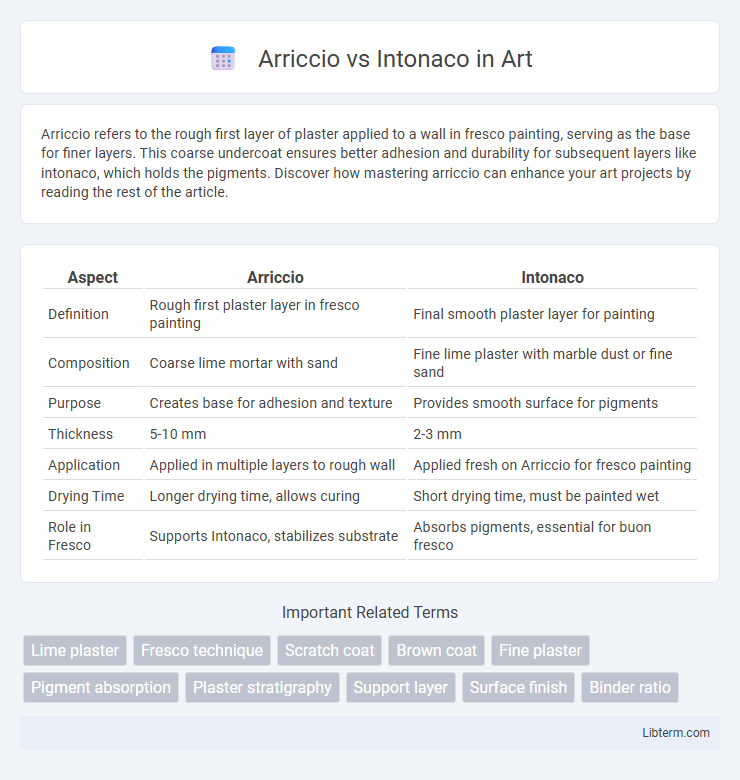Arriccio refers to the rough first layer of plaster applied to a wall in fresco painting, serving as the base for finer layers. This coarse undercoat ensures better adhesion and durability for subsequent layers like intonaco, which holds the pigments. Discover how mastering arriccio can enhance your art projects by reading the rest of the article.
Table of Comparison
| Aspect | Arriccio | Intonaco |
|---|---|---|
| Definition | Rough first plaster layer in fresco painting | Final smooth plaster layer for painting |
| Composition | Coarse lime mortar with sand | Fine lime plaster with marble dust or fine sand |
| Purpose | Creates base for adhesion and texture | Provides smooth surface for pigments |
| Thickness | 5-10 mm | 2-3 mm |
| Application | Applied in multiple layers to rough wall | Applied fresh on Arriccio for fresco painting |
| Drying Time | Longer drying time, allows curing | Short drying time, must be painted wet |
| Role in Fresco | Supports Intonaco, stabilizes substrate | Absorbs pigments, essential for buon fresco |
Introduction to Arriccio and Intonaco
Arriccio is the rough first layer of plaster applied to a masonry wall, serving as the base coat to provide adhesion and leveling for subsequent layers. Intonaco is the smooth, final layer of plaster that creates the surface for painting or fresco application, offering a refined and durable finish. The differences in texture, composition, and purpose distinguish Arriccio as the foundational substrate and Intonaco as the decorative and protective topcoat in traditional plastering techniques.
Historical Origins of Arriccio and Intonaco
Arriccio and intonaco are traditional plaster layers foundational to fresco painting, with arriccio serving as the coarse underlayer and intonaco as the smooth finishing layer. The historical origins of arriccio trace back to ancient Roman construction techniques where coarse lime plaster was used for wall preparation, ensuring durability and adhesion for subsequent layers. Intonaco developed during the Renaissance, refined for its fine texture and quick drying properties to allow precise, detailed pigments to be applied for vibrant fresco artistry.
Composition and Material Differences
Arriccio is a rough undercoat plaster primarily composed of coarse sand and lime, providing a stable base for subsequent layers, while Intonaco is a fine finishing plaster made from fine sand, lime, and sometimes marble dust for a smooth, polished surface. Arriccio's composition emphasizes durability and adhesion, facilitating the workability of the Intonaco layer applied directly over it. Intonaco's finer texture and higher quality materials are essential for detailed fresco painting and a refined aesthetic finish.
Purpose and Function in Plastering
Arriccio serves as the rough undercoat layer in plastering, providing a stable and textured base that enhances adhesion for the subsequent Intonaco finish. Intonaco is applied as the final, smooth plaster layer designed to create the finished surface, offering aesthetic appeal and protection to walls. The Arriccio's primary purpose is structural support and bonding, while Intonaco focuses on durability, refinement, and visual quality.
Application Techniques: Arriccio vs Intonaco
Arriccio serves as the rough first layer of plaster applied directly onto the masonry to create a textured surface for better adhesion, typically troweled on in a coarse, uneven manner. Intonaco is the smooth, final layer of plaster applied over Arriccio, spread thinly and evenly to provide a polished finish suitable for painting or fresco work. Skilled artisans must control drying times and moisture levels during application to prevent cracking and ensure a durable bond between Arriccio and Intonaco layers.
Drying and Curing Processes
Arriccio, the initial rough layer of plaster, requires a longer drying period of approximately 7 to 14 days to ensure proper moisture evaporation and structural stability. Intonaco, applied as the final smooth layer, demands a controlled curing process often lasting around 24 to 48 hours to achieve optimal hardness and surface finish. Both layers rely on adequate drying times to prevent cracking and ensure lasting adhesion in fresco painting techniques.
Role in Fresco Painting
Arriccio serves as the rough undercoat of plaster in fresco painting, providing a textured base that ensures proper adhesion of the subsequent intonaco layer. Intonaco is the smooth, final layer of fine wet plaster applied over the arriccio, onto which the artist paints directly while it is still wet to achieve lasting color fixation. This layered approach optimizes the fresco's durability and vibrancy by allowing pigments to chemically bond with the intonaco's calcium carbonate as it dries.
Durability and Longevity
Arriccio serves as the rough undercoat in plasterwork, providing a durable base layer that ensures strong adhesion for the final coat. Intonaco, the smooth finishing layer, offers enhanced longevity by creating a hard, weather-resistant surface that protects underlying structures. Together, these layers optimize the plaster's overall durability and extend the lifespan of walls and facades.
Common Mistakes and Troubleshooting
Common mistakes in applying Arriccio include uneven thickness and inadequate curing time, leading to weak adhesion and cracking issues. Intonaco errors often involve improper mixing ratios and premature application before the Arriccio base fully sets, causing peeling and surface imperfections. Troubleshooting these problems requires ensuring consistent Arriccio layering, proper moisture conditions, and allowing sufficient drying time before applying Intonaco for optimal plaster durability.
Choosing the Right Layer for Your Project
Arriccio serves as the rough undercoat layer in plastering, providing a durable base that enhances adhesion for the smoother intonaco finish layer. Intonaco functions as the final, refined surface, offering a polished appearance and sealing the underlying arriccio to protect against moisture and wear. Selecting the right layer depends on the project's requirements: arriccio is essential for structural support and bonding, while intonaco is ideal for aesthetic finish and surface protection.
Arriccio Infographic

 libterm.com
libterm.com